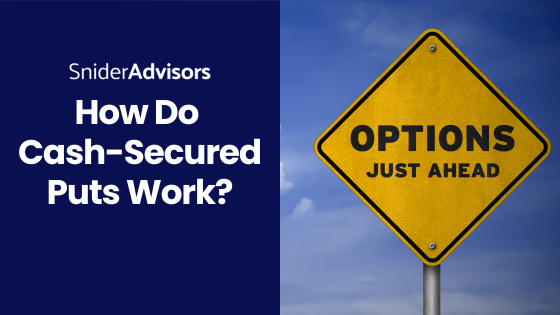Options are often associated with speculation, but many investors use them strategically to generate income or achieve long-term goals. One such approach is the cash-secured put, which offers an alternative way to purchase stock at a discount while collecting option premium income. With this strategy, investors earn a cash premium upfront—income they keep regardless of whether the option is exercised.
Let’s take a closer look at how cash-secured put strategies work and whether they’re the right option to meet your investment goals.
What Are Cash-Secured Puts?
A cash-secured put involves writing (selling) a put option—usually at-the-money or out-of-the-money—while setting aside enough cash to purchase the underlying stock if assigned. The strategy generates an immediate premium, but most investors use it with the intention of acquiring shares at a lower cost during a market pullback.
Profit-Loss Diagram for Cash-Secured Puts – Source: Fidelity
For example, suppose that you short one 60 put option and set aside $6,000 in cash. You also receive an immediate $500 in premium income. If the stock price stays above the $60 strike price, you keep the $500 in premium income. If the stock falls below the strike price, you keep the $500 and acquire the stock at the $60 strike price.
This creates two advantages: you may acquire stock below its current price, and you always keep the premium. The main drawback is that profits are limited to the premium, and if the stock rises sharply, you miss out on that upside potential.
Risk-Reward Profile
Cash-secured puts have a unique risk-to-reward profile that you should be familiar with before using them. Like other put options, cash-secured put options have a negative delta, which means that they don’t move dollar-for-dollar with changes in the underlying price. In-the-money put options react more than out-of-the-money put options.
The maximum profit is equal to the option premium received ($500 in the above example). On the other hand, the maximum loss is similar to owning the stock since you’re obligated to acquire the stock at the strike price ($60 in the above example), although these losses are partially offset by the premium. The breakeven price is the strike price minus the option premium.
Volatility has a neutral to slightly negative impact on cash-secured put strategies, although time decay has a positive impact on the strategy, assuming everything else remains equal. While there’s a slight assignment risk, depending on the strike price, most investors use the strategy to acquire stock, making assignment risk less important.
Using Cash-Secured Puts
Cash-secured puts involve relatively little management when you want to own the underlying stock. If the stock price is below the strike price at expiration, the put option will be assigned and you don’t need to do anything. You will buy the shares with the cash held in reserves, hence the name “cash-secured”.
If the stock price is above the strike price at expiration, then the put option expires worthless and the premium is kept as income. You must then decide if you want to buy the stock at the current market price, sell another put option or invest the cash somewhere else. The biggest risk is that you’d need to pay more to acquire the stock.
If you want to avoid assignment, you can roll cash-secured puts to kick obligations down the road. For example, you might enter a buy-to-close order for the original short put and simultaneously sell to open a put option further out in time and lower in price. In some cases, you can even realize a net credit from the roll if the new option is further out of the money.
It’s typically a good idea to roll out cash-secured puts across a short time frame before they go too far in-the-money. Put options that are too far in-the-money can be challenging to roll at a reasonable price, which means that you may be forced to take assignment. Preemptive rolls when the price is trending down can help mitigate these problems.
Cash-Secured Puts vs. Covered Calls
Cash-secured puts are often compared to covered calls because both strategies generate income from option premiums and share similar payoff diagrams. However, there are key differences:
There are also several key differences:
- Investor objective: Put writers generally want to acquire stock at a lower price; call writers want to generate income from shares they already own.
- Dividends: Covered call writers collect dividends; put writers do not.
- Profit sources: Put writers earn only premiums, while call writers may benefit from stock appreciation if their calls are out-of-the-money.
In general, covered calls suit investors looking to earn income on existing holdings, while cash-secured puts are best for those who want to add shares to their portfolio at an attractive entry price while still generating income.
The Bottom Line
Cash-secured puts are a versatile strategy for investors who want to purchase stock below its current market price while collecting premium income. While they share similarities with covered calls, their primary use is stock acquisition rather than ongoing income generation.
The Snider Investment Method provides a structured approach for using both cash-secured puts and covered calls to create a reliable income stream. Explore our free e-courses or learn more about our asset management services to see how these strategies can work for you.
